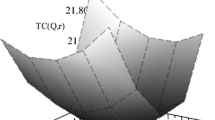Abstract
In this article, we consider the analysis of a continuous review (Q, r) inventory model with a mixture of back orders and lost sales, assuming Weibull distribution for the lead time demand (LTD). The use of generalized λ-type distribution (GLD) in approximating the LTD is demonstrated. Through numerical studies, optimal values of the policy parameters are obtained under GLD approximation method, the distribution free approach, and the exact case. Further, the expected value of additional information (EVAI) which serves as a measure of efficiency of the procedure is provided for both the GLD and the distribution free procedures.
Similar content being viewed by others
7. References
Abramovitz M and Stegun I A “Handbook of Mathematical Functions”. Washington D.C, U.S. Govt. Printing Office, New Jersey (1972).
Fortuin L. “Five populär probability density functions: A comparison in the field of stock control rnodels”. J.Opl.Res.Soc. 31 (1980) 937–942.
Gallego G. “A minmax distribution free procedure for the (Q.r) inventory model”. Opns. Res. Lett. 11 (1992) 55–60.
Hadley G and Whitin TM. “Analysis of Inventory Systems”. Prentice-Hall, Englewood Cliffs, New Jersey (1963).
Kottas JF and Lau HS. “The use of versatile distribution families in some stochastic inventory calculations”. J.Opl.Res.Soc. 31 (1980) 393–403.
Kumaran M and Achary KK. “On approximating lead time demand distributions using the generalised x-type distribution”. J.Opl.Res.Soc. 47 (1996) 395–404.
Montgomery D Bazaraa M and Keswani A. “Inventory rnodels with a mixture of backorders and lost sales”. Naval. Res. legist.Q. 20 (1973) 255–263.
Moon I and Gallego G. “Distribution free procedures for some inventory rnodels”. J.Opl.Res.Soc. 45 (1994) 651–658.
Ouyang LY Yeh NC and Wu KS. “Mixture inventory model with backorders and lost sales for variable lead time”. J. Opl. Res. Soc. 47 (1996) 829–832.
Ramberg JS and Schmeiser BW. “An approximate method for generating asymmetric random variables”. Comm ACM. 17 (1974) 78–82.
Ramberg JS Tadikamalla PR Duduwicz ET and Mykika EF. “A probability distribution and its use in fitting data”. Technometrics. 21 (1979) 201–214.
Scarf H. ‘A min-max solution of an inventory problem’. “Studies in the Mathematica! Theory of Inventory and Production” (Arrow K, Karlin S and Scarf H. Eds). Stanford University Press, California (1958) 201–209.
Tadikamalla PR. “Applications of the Weibull distribution in inventory control”. J. Opl. Res. Soc. 29 (1978) 77–83.
Author information
Authors and Affiliations
Rights and permissions
About this article
Cite this article
Achary, K.K., Geetha, K.K. A Note on the Analysis of (Q.r) Policy : GLD Approximation vs Distribution Free Approach. OPSEARCH 38, 223–234 (2001). https://doi.org/10.1007/BF03399227
Received:
Accepted:
Published:
Issue Date:
DOI: https://doi.org/10.1007/BF03399227




